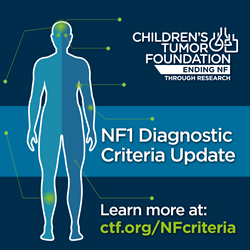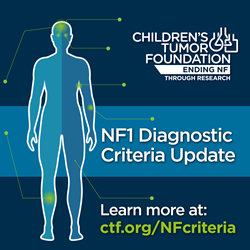
NEW YORK (PRWEB)
May 19, 2021
The Children’s Tumor Foundation (CTF) today announced the publication of updated diagnostic criteria for the genetic disorder neurofibromatosis type 1 (NF1) in Genetics in Medicine, the official journal of the American College of Medical Genetics and Genomics. The new publication is the result of an extensive, multi-year collaborative effort of over 90 leading neurofibromatosis (NF) experts from around the globe, and is aimed at improving the accuracy and earlier diagnosis of NF1 in patients, thus ultimately leading to improved care and quality of life for those patients. Today’s announcement is being made on the occasion of NF Awareness Month, a global awareness initiative focused on increasing recognition of all the forms of neurofibromatosis and schwannomatosis.
The original diagnostic criteria for NF1 and NF2 were established at the National Institutes of Health (NIH) consensus meeting in 1987, and the diagnostic criteria for schwannomatosis was established in 2005. Since that time, there has been an explosion of knowledge about these genetic disorders, including the discovery of the genes that cause NF1, NF2, and schwannomatosis, as well as the technological development of genetic testing. In recent years, NF clinicians have noted that an updated consensus was needed to better communicate (for both medical professionals and patients) the distinctions between NF1, NF2, and schwannomatosis, as patients were at times being misdiagnosed or receiving delayed diagnosis and care.
As a result, in 2017 a group of NF investigators reached out to the Children’s Tumor Foundation, the largest nongovernmental funder of all forms of NF research in the world, to sponsor a review and potential revision of the NF diagnostic criteria. That group of investigators grew into a worldwide effort that utilized the following guiding principles in the development of the updated criteria:
-
Formulate a clear delineation between NF1, NF2, and schwannomatosis criteria - Represent the best consensus among NF experts
- Reflect input from patients, caregivers, families, foundations, and advocacy groups
- Exclusively address the issues of diagnosis (rather than clinical management)
- Be broadly representative of medical specialties
- Be usable by general doctors as well as NF specialists
- Recognize advances in genetics without requiring genetic analysis for diagnosis
- Be relevant in different countries and health care systems, now and in coming years
While the review of all forms of NF were conducted concurrently by the expert groups, it is the updated NF1, Legius syndrome, and mosaic NF criteria that are available at this time, with the NF2 and schwannomatosis criteria release to come later this year.
The results of today’s update are now publicly available in the publication Genetics in Medicine, in an article entitled “Revised Diagnostic Criteria for Neurofibromatosis Type 1 and Legius Syndrome: An International Consensus Recommendation”. The article can be found here. All the names of the participants in the International Consensus Group on Neurofibromatosis Diagnostic Criteria can be found in the paper.
In the article, the authors outline the following:
Purpose: by incorporating major developments in genetics, ophthalmology, dermatology, and neuroimaging, to revise the diagnostic criteria for neurofibromatosis type 1 (NF1) and to establish diagnostic criteria for Legius syndrome (LGSS).
Methods: using a multistep process, beginning with a Delphi method involving global experts and subsequently involving non-NF experts, patients, and foundations/patient advocacy groups.
Results: reached consensus on the minimal clinical and genetic criteria for diagnosing and differentiating NF1 and LGSS, which have phenotypic overlap in young patients with pigmentary findings. Criteria for the mosaic forms of these conditions are also provided.
Conclusion: the revised criteria for NF1 incorporate new clinical features and genetic testing, whereas the criteria for LGSS were created to differentiate the two conditions. It is likely that continued refinement of these new criteria will be necessary as investigators (1) study the diagnostic properties of the revised criteria, (2) reconsider criteria not included in this process, and (3) identify new clinical and other features of NF and related disorders.
In coming months, the Clinical Care Advisory Board of the Children’s Tumor Foundation, in partnership with NF clinics, medical groups, and other NF organizations, will roll out a multi-format education program of the updated criteria for both general physicians and NF experts, to increase knowledge and advance care of the various forms of neurofibromatosis.
NF, short for neurofibromatosis, is a group of rare genetic disorders that cause tumors to grow on nerves throughout the body, includes three distinct forms (NF1, NF2, or schwannomatosis), and affects all ethnicities, races, and genders equally. In addition to tumors growing anywhere in the body, NF can lead to blindness, deafness, bone abnormalities, disfigurement, learning disabilities, disabling pain, and cancer. NF affects 1 in 3,000 births, and while the FDA in 2020 approved the first-ever treatment for NF1, Koselugo (selumetinib) for inoperable plexiform neurofibromas, there is no cure at this time for NF, which is why it is crucial to improve diagnosis, and ultimately, medical care, treatment, and research for the over 2.5 million people worldwide living with NF.
Driving the goal for increased awareness and funding for NF is the Children’s Tumor Foundation’s global awareness campaign, called Make NF Visible. This multi-format activation was launched in May, for NF Awareness Month, a dedicated time each year that brings attention to the inspirational and extraordinary stories of those living with NF, and the critical need for research to better their lives. Learn more about the Make NF Visible campaign at makenfvisible.org.
On the occasion of NF Awareness Month (May) and the publication of the updated diagnostic criteria, the Children’s Tumor Foundation has also created an online patient-focused site which will host updated patient brochures, webinar links, and other important tools including upcoming phone apps, that will contain information to be shared with patients, caregivers, families, educators, researchers, and clinicians. New resources, links to publications, news (including the announcement of NF2 and schwannomatosis criteria) will be posted throughout the year at ctf.org/nfcriteria.
To learn more about the Children’s Tumor Foundation and Children’s Tumor Foundation Europe, including research priorities, patient programs, community initiatives, and more, visit ctf.org and ctfeurope.org.

